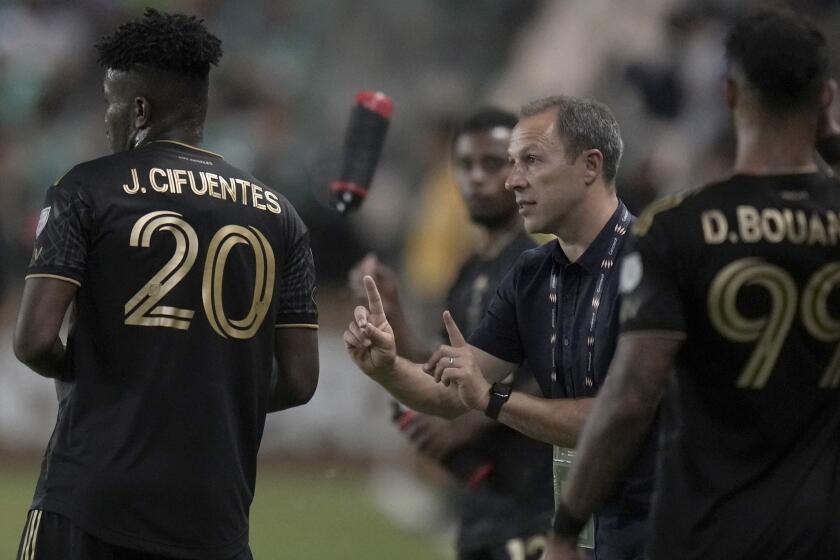Business Booming in the Minor Leagues
- Share via
SAN FRANCISCO — The headlines told a shocking story during last year’s short-lived major league players strike.
Major league baseball had joined the likes of Chrysler, Apple Computer and New York City as American institutions that had run into financial problems. A tidal wave of red ink in the ledgers of some club owners was threatening to wash away the basic structure of America’s game.
However, away from the big city glitter and heat of the media lights, professional baseball was enjoying an economic renaissance. Record crowds were rediscovering the joys of 50 cent hot dogs, dollar beers and cheap family entertainment at minor league parks across the country.
Louisville, a St. Louis Cardinals triple-A franchise, drew somewhere around a million fans in 1985 ranking it in attendance above major league teams in Pittsburgh, Cleveland and San Francisco. The Yankees’ triple-A franchise in Columbus, Ohio, attracted more than 500,000. As a whole the minor leagues drew nearly 19 million fans last year.
This season the minor leagues are looking for even a better year. In fact, business is booming.
“The pre-season sales figures for advertising and tickets from around the country indicate we are in for another big year,” said Sal Artiaga, an administator with the National Association of Professional Baseball Leagues. “We are on a definite upswing. New stadiums are sprouting up all over the country. Shreveport (La.) and Richmond (Va.) will have new facilities this season just to name two.”
Texas League president Carl Sawatski was even more bullish with his predictions.
“Back 10 years ago this league (made up of double-A teams) drew about 650,000 fans,” he said. “Over the last six years, we’ve drawn over a million each season and I think we’ll get near the 1.5 million mark this year.”
Sawatski said he thought the economic success of the minor leagues was due to holding tightly to a simple formula.
“We’ve kept the prices down on tickets and concessions,” the league president said. “That has brought people back to the park. I noticed a trend while traveling around the league last year of young people coming back out to the parks and really having a good time.”
Even in the Pacific Coast League, whose franchises are located in such far reaches as Honolulu, Calgary, Alberta, Canada and Albuquerque, there has been an improvement in the financial environment.
“Our attendance was up about 168,000 over the year before,” said PCL president Bill Cutler. “But our league faces a unique problem. It is expensive to run a PCL team because the franchises are so spread out. It wouldn’t be unusual for a club to spend $75,000 on travel. I think that is unheard of in the other two triple-A leagues.”
The travel expenses have the 10-team PCL thinking about expanding.
“We would like to add two teams to our league,” Cutler said. “A setup with two 6-team divisions would likely cut each team’s expenses in half.”
The minor leagues have also benefitted from working agreements with major league clubs. Most minor league clubs have such agreements in which the major league team picks up the salaries of the players and coaches.
However, Joe Gagliardi, a long-time minor league owner and now president of the Class-A California League, says it is still easy for a team to be a big money loser.
“You can have all the working agreements you want, but if you are a bad businessman, you can still lose thousands of dollars,” he said. “To be successful, a minor league team has to be run more like a business instead of a hobby.”
Roger Noll, an economist at Stanford University who has studied the baseball industry, said he saw two reasons why minor league teams are more economically successful than their major league counterparts.
“Obviously, minor league teams are less likely to be showcases for their owners,” he said. “Players are paid on ability and not their names. There is also a sports boom going on and I think its a healthy thing for baseball.”
Noll said fans are also attracted to the minor league parks because the talent is better than in years past.
“I think baseball, in part, is being bitten by its own quest for dollars in the past,” he said. “Driven by the fact that the major leagues, because of television and expansion, have limited the size of the minor leagues, there are now not enough minor league training spots for young players. This has put the minor league owner in a much better position.”
The economic boom on the minor league level has driven up the price of a minor league franchise to new highs.
“In 1977, you could pick up a California League franchise for about $20,000,” Gagliardi said. “Then in 1980, it started to mushroom. Today, it would cost about $200,000 to buy a franchise. The closest thing I can compare the large price increase to is the way California real estate took off. A house that cost $150,000 10 years ago is now worth $500,000.”
Sawatski said in the Texas League the value of a team now ranges anywhere from $300,000 to $600,000.
“The price will vary depending upon location,” the league president said. “This year, the San Antonio franchise sold for $500,000.”
At the triple-A level, Cutler says the price of a franchise is about $1 million.
More to Read
Go beyond the scoreboard
Get the latest on L.A.'s teams in the daily Sports Report newsletter.
You may occasionally receive promotional content from the Los Angeles Times.










